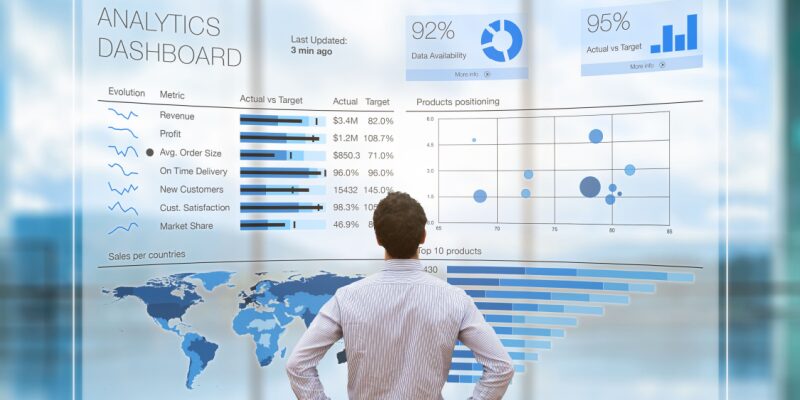Understanding the Foundation: AI and Big Data Integration
The integration of AI and Big Data creates a powerful foundation for real-time analytics. AI algorithms, driven by massive datasets, enable businesses to extract meaningful patterns and trends at an unprecedented pace. From customer behavior to market dynamics, the synergy between AI and Big Data provides a holistic understanding of complex datasets, unlocking actionable insights in real-time.
- Advanced Data Processing with AI Algorithms:
Machine Learning Models: AI algorithms, particularly machine learning models, play a pivotal role in processing and interpreting massive datasets. These models are capable of learning and evolving, enabling businesses to uncover intricate patterns, correlations, and anomalies within the data.Natural Language Processing (NLP): NLP, a subset of AI, enhances the understanding of unstructured data, such as text and speech. By leveraging NLP, businesses can extract valuable insights from sources like customer feedback, social media, and textual data, contributing to a more comprehensive analysis. - Real-Time Decision-Making:
Instantaneous Pattern Recognition: The integration of AI allows for real-time pattern recognition, enabling businesses to make decisions on the fly. Whether it's identifying market trends, predicting customer behavior, or responding to dynamic operational changes, real-time decision-making becomes a reality with the fusion of AI and Big Data.Automated Insights Generation: AI-driven systems automate the generation of actionable insights in real-time. These systems continuously analyze incoming data streams, providing immediate feedback and recommendations to decision-makers, reducing the lag between data acquisition and strategic responses.
- Adaptive BI Dashboards:
Dynamic Visualization: Traditional BI dashboards often struggle to keep up with the pace of changing data. AI-infused BI dashboards dynamically adapt to evolving datasets, ensuring that visualizations remain relevant and insightful in real-time. This adaptability enhances user experience and facilitates more effective monitoring and analysis.Predictive Analytics Integration: AI enables the incorporation of predictive analytics directly into BI dashboards. Users can not only observe current data but also receive predictions and forecasts, empowering them to proactively address challenges and seize opportunities as they arise.
- Continuous Learning and Improvement:
Iterative Model Training: The continuous influx of Big Data allows AI models to undergo iterative training. This iterative learning process enhances the accuracy and relevance of AI algorithms over time, ensuring that the system stays adaptive to changing business dynamics.Feedback Loops: Real-time feedback loops enable AI systems to learn from outcomes and adjust their models accordingly. This constant feedback mechanism contributes to the refinement and optimization of AI algorithms for more precise predictions and analyses.
Understanding the foundation of AI and Big Data integration is crucial for businesses seeking to leverage real-time analytics effectively. This synergy empowers organizations to extract meaningful insights, make informed decisions on the spot, and stay agile in an ever-evolving business landscape.
Enhancing Decision-Making with Dynamic BI Dashboards
Traditional BI dashboards often fall short when it comes to delivering insights in real-time. The article explores how the fusion of AI and Big Data facilitates the creation of dynamic BI dashboards that adapt to changing data streams. These dashboards not only provide instantaneous updates but also leverage AI algorithms to deliver predictive analytics, allowing businesses to stay ahead of the curve.
- Instantaneous Data Visualization:
Adaptability to Real-Time Changes: Dynamic BI dashboards are designed to adapt swiftly to real-time changes in data. This adaptability ensures that decision-makers are presented with the most current and relevant visualizations, allowing for quick assessments and informed decision-making.Live Updates: The integration of AI allows for live updates on dynamic dashboards. This feature ensures that decision-makers are not reliant on periodic reports but have a continuous flow of information at their fingertips.
- Predictive Analytics Integration:
Real-Time Predictions: Dynamic dashboards infused with AI capabilities enable the integration of predictive analytics directly into the visualization. Decision-makers can not only view historical and current data but also receive AI-driven predictions and forecasts, empowering them to make anticipatory decisions.Scenario Planning: Decision-makers can use predictive analytics on dynamic dashboards for scenario planning. By simulating various scenarios based on AI predictions, businesses can strategize and optimize their responses to different future outcomes.
- User-Centric Adaptability:
Customization Features: Dynamic BI dashboards prioritize user-centric adaptability. Decision-makers can customize dashboards to focus on specific KPIs, metrics, or areas of interest. This adaptability ensures that each user receives a personalized and relevant view of the data.Intuitive User Interface: The interface of dynamic dashboards is designed for ease of use. AI-driven features, such as natural language processing, enable users to interact with the dashboard intuitively, asking questions and receiving instant responses.
- Real-Time Monitoring and Alerts:
Automated Monitoring: Dynamic dashboards with AI integration offer automated real-time monitoring of key metrics. Decision-makers can set thresholds and receive instant alerts when predefined conditions are met or exceeded, allowing for immediate intervention in critical situations.Anomaly Detection: AI algorithms can detect anomalies in real-time data. Dynamic dashboards equipped with anomaly detection features enable decision-makers to quickly identify unusual patterns or outliers, facilitating timely corrective actions.
- Agility in Decision-Making:
Reduced Decision Lag: The dynamic nature of these dashboards significantly reduces decision lag. Decision-makers can respond promptly to changing circumstances, capitalize on emerging opportunities, and address challenges before they escalate.Agile Decision-Making Processes: Dynamic BI dashboards foster agile decision-making processes. The combination of real-time data and AI-driven insights empowers decision-makers to adapt strategies swiftly in a rapidly changing business environment.
Enhancing decision-making with dynamic BI dashboards in the context of AI and Big Data integration represents a paradigm shift in how organizations leverage data for strategic purposes. These dashboards
Leveraging Machine Learning for Predictive Analysis
One of the key aspects of real-time analytics is the ability to predict future trends. The article delves into how machine learning, a subset of AI, plays a pivotal role in predictive analysis. By continuously learning from incoming data, machine learning models can forecast outcomes, enabling businesses to make proactive decisions and capitalize on emerging opportunities.
One of the key pillars of real-time analytics in the fusion of Artificial Intelligence (AI) and Big Data is the utilization of machine learning for predictive analysis. This facet goes beyond traditional analytics by not only providing insights into current data trends but also forecasting future outcomes based on historical patterns and real-time inputs.
- Continuous Learning for Anticipatory Insights:
Adaptive Models: Machine learning models employed in predictive analysis are designed to adapt and evolve continuously. These models learn from historical data, refining their understanding of patterns and trends to generate increasingly accurate predictions.Incremental Updates: As new data streams in, machine learning models receive incremental updates. This enables them to stay current and reflective of the latest trends, ensuring that predictions are not only accurate but also relevant to the present moment.
- Feature Engineering for Complex Pattern Recognition:
Identifying Relevant Features: Machine learning algorithms excel at identifying relevant features within a dataset. This capability is crucial for predictive analysis, as it allows the model to focus on specific variables that significantly influence the outcomes being predicted.Complex Pattern Recognition: Machine learning algorithms can discern complex patterns that may not be apparent through traditional analysis. This intricate pattern recognition enhances the predictive power of the models, enabling them to capture nuances and dependencies within the data.
- Time Series Analysis for Temporal Insights:
Temporal Patterns: Predictive analysis often involves understanding temporal patterns in data. Machine learning algorithms specialized in time series analysis excel at recognizing trends, seasonality, and other time-dependent factors, making them well-suited for forecasting future events.Anomaly Detection: Machine learning models can identify anomalies or deviations from expected patterns in real-time. This capability is particularly valuable for predicting unusual events or disruptions that may impact business operations.
- Proactive Decision-Making with Predictive Analytics:
Strategic Planning: Predictive analysis enables organizations to engage in strategic planning by anticipating future scenarios. Businesses can proactively address challenges and capitalize on opportunities, positioning themselves ahead of competitors.Risk Management: By forecasting potential risks, machine learning models contribute to effective risk management. This allows businesses to implement preventive measures and mitigate potential negative impacts on operations and outcomes.
- Integration with Real-Time Data Streams:
Streaming Analytics: Machine learning models can seamlessly integrate with real-time data streams, allowing for continuous analysis and prediction. This real-time integration ensures that businesses receive timely insights, enabling them to respond promptly to changing circumstances.
Overcoming Challenges: Scalability and Data Processing Speed
Machine learning algorithms designed for predictive analysis are scalable, accommodating the processing of large volumes of data in real-time. This scalability is essential for businesses dealing with dynamic datasets and evolving market conditions.
Case Studies: Success Stories of AI-Infused Real-Time Analytics
To illustrate the practical applications of AI and Big Data in real-time analytics, the article presents case studies of businesses that have successfully embraced this fusion. These real-world examples showcase how organizations across industries have optimized operations, enhanced customer experiences, and gained a competitive edge through the strategic integration of AI and Big Data.
- Retail Revolution: Enhancing Customer Experience
Challenge: A retail giant aimed to improve customer experience and optimize inventory management in real-time.
Solution: AI algorithms were integrated into their data analytics system to analyze customer behavior, predict demand, and dynamically adjust inventory levels.
Outcome: The company experienced a significant reduction in stockouts, improved customer satisfaction, and increased sales. Real-time analytics allowed for instant adjustments to market trends, ensuring the availability of popular products. - Financial Sector Innovation: Fraud Detection and Prevention
Challenge: A financial institution faced challenges in detecting and preventing fraudulent transactions in real-time.
Solution: AI-powered anomaly detection models were implemented to analyze transaction patterns, flagging suspicious activities instantly.
Outcome: The institution witnessed a substantial decrease in fraud-related losses and increased confidence among customers. Real-time analytics enabled swift response to potential threats, minimizing financial risks. - Healthcare Optimization: Predictive Patient Care
Challenge: A healthcare provider sought to enhance patient care by predicting potential health issues and optimizing resource allocation in real-time.
Solution: Machine learning models were employed to analyze patient data, predict health risks, and allocate resources dynamically based on patient needs.
Outcome: The organization achieved improved patient outcomes, reduced hospital readmissions, and optimized resource utilization. Real-time analytics allowed for timely interventions and personalized patient care. - E-commerce Efficiency: Supply Chain Optimization
Challenge: An e-commerce company faced challenges in optimizing its supply chain to meet fluctuating demand.
Solution: AI algorithms were integrated to analyze historical sales data, predict demand patterns, and optimize inventory levels and distribution networks in real-time.
Outcome: The company experienced reduced logistics costs, minimized excess inventory, and improved order fulfillment efficiency. Real-time analytics enabled adaptive supply chain management to respond to changing market demands. - Manufacturing Excellence: Predictive Maintenance
Challenge: A manufacturing plant aimed to minimize downtime and maintenance costs by predicting equipment failures in real-time.
Solution: AI-driven predictive maintenance models were implemented to analyze sensor data, predict equipment failures, and schedule maintenance proactively.
Outcome: The plant achieved a significant reduction in unplanned downtime, lowered maintenance costs, and improved overall equipment efficiency. Real-time analytics allowed for predictive insights into equipment health. - Telecommunications Optimization: Network Performance Management
Challenge: A telecommunications company sought to optimize network performance and enhance user experience in real-time.
Solution: AI algorithms were integrated into network monitoring systems to analyze data traffic, predict potential network congestion, and dynamically optimize routing.
Outcome: The company achieved improved network reliability, reduced latency, and enhanced customer satisfaction. Real-time analytics allowed for proactive adjustments to network conditions.
In the dynamic intersection of AI and Big Data, real-time analytics stands as a testament to the transformative power of data. This article aims to guide businesses through the intricacies of this fusion, offering a comprehensive understanding of how AI and Big Data are redefining the boundaries of Business Intelligence in the pursuit of real-time insights.






